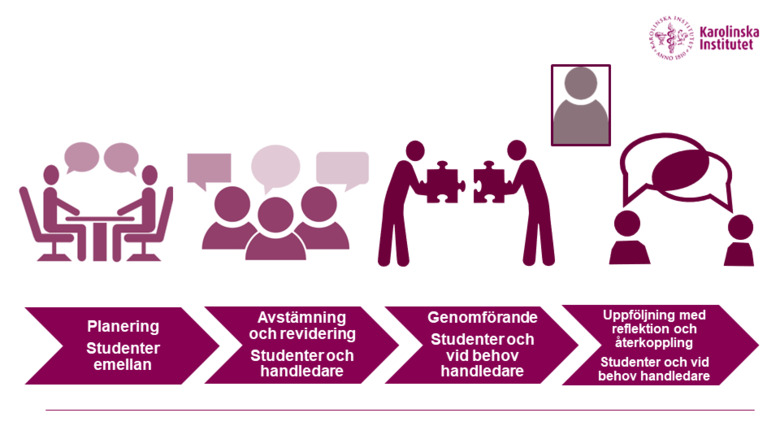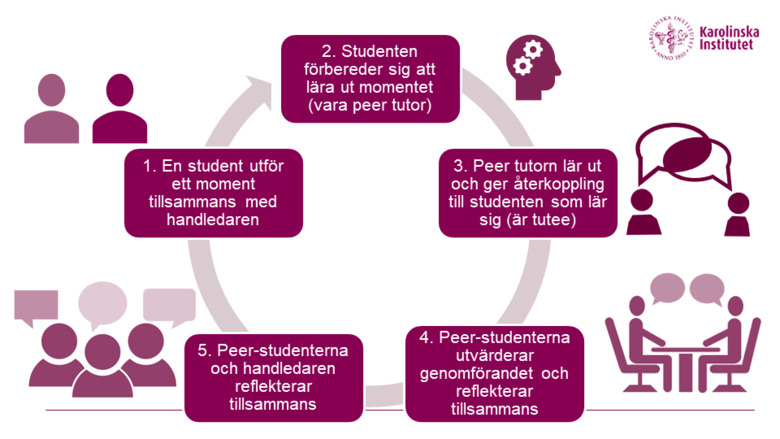Structured learning activities - Peer learning
A structured learning activity involving peer learning can take various forms, but typically includes the following components: planning, alignment, execution, and follow-up. This page aims to provide som inspiration for you when initating a peer learning activity.
Peer learning can be implemented across an entire organisation, such as within a student unit that embraces peer learning as a pedagogical method. In such cases, peer learning becomes an integral part of the organisation's pedagogical approach.
Additionally, an organisation can incorporate peer learning in varying degrees by using one or more structures learning activities as i seen fit. These activities allow students, guided by their learning objectives, to learn from and with each other during specific moments or activities.
Examples of activities where peer learning could be used:
- admission and discharge of patients
- planning and conducting rounds
- delegation of various tasks
- handling technical equipment
- trying out technical aides
- patient interaction and communication
- handling of samples
- teaching healthcare personnel
- joint home visits
- documentation and record-keeping
- patient and family education or group instruction
- sensitive conversations
- skills training
Examples of peer learning-process'
The upper image below describes a peer learning process that is quite common, where students prepare together, perform a task, and then reflect on how it went with more or less support from a supervisor in the process.
Peer teaching or tutoring, as seen in the lower image, can be good to use when a supervisor needs to be involved initially in the implementation of a task. It can, for example, be about situations that needs to be practiced in action- situations that are difficult to practice in advance.


The role and responsibilities of the students
- Identify, possibly together with a supervisor, learning needs and plan an activity that is common in the workplace and based on the course’s learning objectives. It is recommended to have specific goals for the activity itself.
- Acquire the appropriate knowledge, both theoretical and practical.
- Determine the role distribution in the student couple such as observer and performer, or alternatively, perform the activity together.
- Prepare the task and, where applicable, inform the patient and relatives of what is going to happen and that peer learning is used.
- Check and follow up the action plan with the supervisor before the task is performed, this is sometimes called pre-supervision.
- Adjust the planned approach, prepare, and be ready to act in various scenarios.
- Carry out the activity according to the already determined roles.
- Plan and carry out feedback based on the agreed-upon terms and reflect together in the student couple on what happened. The supervisor can initially be involved or join later.
The role and responsibilities of the supervisor
- Lead the students through the work and support the process and planning.
- Ensure that the task is at the right level for the students and that is relevant in relation to the learning objectives.
- Be readily available for support.
- Show where information and materials can be found.
- Check with the students before performing the task. This gives the supervisor the opportunity to assess what support the students need and to consider any safety aspects and be prepared for supervision in case of unforeseen events.
- Follow up on the students’ learning with brief check-ins and scheduled feedback and a maybe a logbook continuously.
- Be present during the performance if needed.
- Evaluate and reflect together with the students.
- Based on the learning objectives, make an individual assessment of the students’ performance.
- Be more actively engaged in the beginning and take the role as an observer towards the end of the students' placements if they are with you for a longer period of time.
Assessment
In peer learning, the student practices assessing not only their own performance but also their fellow student’s in relation to the learning objectives. This means that students need to practice giving and receiving feedback in a structured and constructive manner. The students plan their learning activity so that it is clear what should be given feedback on, as well as where and how the feedback should take place.
The roles in the activity execution need to be planned and stated. For example, if there is an observer during a learning activity, their tasks need to be formulated together—what is to be assessed and given feedback on? Peer learning provides opportunities for more feedback occasions when students practice a task, but it is the supervisor who assesses the student i relation to the objectives as the basis for grading. This can be done through direct observation, but through the students’ reflection after the implementation, the supervisor can also get an impression of what the students have understood.
It is important for the supervisor to see the students as individual persons and not as a unit and that the students receive individual feedback on their performance in relation to the learning objectives, also from the supervisor. The supervisor is responsible for the assessment on which the educational institution bases the final grade.
Challenges with peer learning
Peer learning can be challenging, often mentioned are difficulties relating to when students are not at the same level of knowledge, if they are not equally motivated, or if someone takes up more space in the collaboration. A non-functioning collaborative relationship can then emerge, something that the supervisor needs to be observant of and identify early in order to develop ways to solve it, preferably in collaboration with the students. To avoid or solve a problematic learning relationship it is encouraged to follow a structure; who does what during an activity, should one observe and the other be active, or should one assist the other? If this is agreed upon beforehand and there is a plan to follow, it can make it easier for the supervisor to step in and manage the collaboration during the activity if necessary.
To assess the students' individual abilities to reach the learning objectives, the supervisor may need to see the students in individual activities. The supervision strategies might need to be evaluated and adjusted a long the way.
References
Stenberg, M. (2017). Peer learning. I Sandberg, H (red). Pedagogik för sjuksköterskor. Studentlitteratur.
